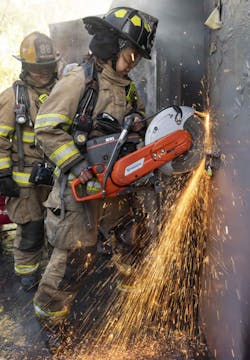The probationary period for new firefighters is extremely important in their career development. It’s used to refine what they have learned in the academy, to introduce them to the fire department culture, and to expand on specific tasks that are performed by engine and truck companies.
Nowhere is this more apparent than the time that’s spent learning the uniqueness of truck company functions. This mainly is because truck companies have many possible jobs at fires and other specialty incidents, and the time that’s devoted to that immense amount of work at the fire academy—including vertical ventilation, extrication, forcible entry and understanding aerial deployment—usually is minimal.
I was a truck captain on a busy downtown company for many years, and a majority of the probationary firefighters were assigned to their ladder rotation on our truck. I always welcomed the opportunity because of the pride that I have in truck company work. It also allowed my assigned firefighters a chance to “own” a piece of the crew by being a crucial part in teaching assorted topics to the probationary firefighters. As well, it gave me a chance to make sure that the assigned firefighters taught things the way that I wanted them done, which ensured their understanding of the tasks, too.
Many probationary firefighters did hoseline operations at the academy all day long and, thus, knew how to handle a nozzle or take a plug, However, put a chainsaw in their hands and tell them to walk the roofline and cut a vertical ventilation hole, and you saw how much practice that they needed.
Mechanical aptitude
One of the first things that I did was get an idea of the probationary firefighters’ mechanical aptitude. Do they know what two-cycle fuel is? Do they know how to use the choke to start a saw, fan or power plant? Do they understand basic tool usage?
You can’t count on the newer generation to have a hands-on mentality. It’s our job to teach them how to get their hands dirty.
We also operated a ladder tender and a support truck at our station, so there was a lot to remember when it came to which equipment was located in which compartment. I gave probationary firefighters a week to memorize what was contained in each compartment in each truck and then tested them. The last thing I wanted was a firefighter running circles around the truck looking for a particular tool.
I had them cut residential and commercial holes repeatedly until they were comfortable with their footwork and chainsaw performance.
The final training test was the unexpected nighttime residential vertical ventilation cut. We made an excuse to go out at night then drove into our training center. We turned on the lights and siren and acted as though we were on a house fire, in real time, and got ordered to ventilate the roof. The probationary firefighter then turned out, donned SCBA as fast as possible, threw a ground ladder and followed the crew to the roof to cut a safe and effective ventilation hole.
Things look differently at night through your SCBA mask. It took a unanimous vote by the crew for the probationary firefighter to be “up” for his turn at an actual ventilation hole.
More tools and tasks
There were air bags for lifting heavy objects to understand, conquering the basics of throwing ground ladders, correctly setting up for positive pressure ventilation and knowing how to tie proper knots.
Flat-head axes, pickaxes, the Rabbit Tool, Halligans, hammers, wrenches, handheld battery-powered tools and other assorted tools, the amount of which might rival a small home-improvement store. They all must be cared for and kept in a ready state, and the probationary firefighter must learn how to do that.
The probationary firefighter would come to know that our truck usually was the last to leave the fireground, after making sure that salvage and overhaul was complete and that any ventilation hole that was made in the roof was covered to prevent rain from entering as a customer service. (I never had a rekindle of a structure fire, and our crew took pride in the work that it took to prevent that.)
Other important learning aspects were how to help to quickly set up the outriggers for aerial deployment and how to enter the bucket with the appropriate tools and to use the ladder belt. We set up the bucket as a high directional for technical rescue calls and practiced attaching a stokes basket to the bucket as an option to bring down an injured person.
We let them get the feel of driving a 63-foot, 43,000-lb., million-dollar fire truck around the academy grounds and take turns flying the bucket to the roof, all for them to get an understanding of what the other firefighters and engineers did during that assignment.
Brief but lasting
In the end, a wide-eyed, somewhat intimidated probationary firefighter usually would gain a better appreciation for what a truck company does and how those tasks are accomplished. All too soon, it seemed, the rotation was over. The education and experience that probationary firefighters received would sometimes be the last that they would get on a truck company—but the experience would last their career.
About the Author

Gibby Gorman
Gibby Gorman recently retired from his fire service career after nearly 33 years, which began in 1986 with the Tempe, AZ, Fire and Medical Department, where he served for 27 years. During that time, Gorman: worked as a downtown ladder captain for 14 years; responded on the SCUBA Rescue Team; worked on the hazmat team; served as coordinator for the Regional Technical Rescue Teams; taught fire science classes at the community college level; and presented ladder tactics for Firehouse World conferences,, including in 2020. In 2013, he became a battalion chief for the Maricopa, AZ, Fire and Medical Department. Gorman created Southwest Firefighting Concepts. He received his bachelor’s degree from Arizona State University.

